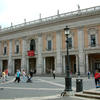More about Capitoline She-Wolf

Contributor
The Capitoline She-wolf represents the ancient origins of Rome.
So what better place to store them than in the oldest museum in the world, the Capitoline Museums?
The two small boys suckling at the wolf’s teats are Romulus and Remus, the founders of Rome, and the she-wolf is the mother of the city. This is a foundation myth that dates back to the fourth century. The story goes that Romulus and Remus were twins, sons of Rhea Silvia and the god of war, Mars. This isn’t a Vincent-and-Theo tale of brotherly love. It ends with one brother being killed and the other finding a new city, and it’s a long and hard road before they get there.
The story is a tragedy filled with family issues. Rhea’s uncle, Amulius, forced her into a vow of chastity, for fear that her descendants would seek revenge on him and take the power he had stolen from his own brother. The vow didn’t stop Mars from raping her. Once Rhea fell pregnant, Amulius’s concern for his own safety became real, and so he sent his servants to drown the twins. It was on that day that he learned the old saying, “If you want to get the job done right, do it yourself.” His servants, afraid of getting too close to the rising Tiber River, abandoned Romulus and Remus on the shores and assumed nature would take its course. Of course, this didn’t happen. They washed up near the Palatine Hill and were found by a mama wolf who had recently lost her own cubs.
What’s not included in this statue is the woodpecker that Mars sent to help care for his sons. After being nursed by the wolf, Faustulus, our story’s most humble shepherd, cared for the boys until adulthood, when they came back for Amulius in the greatest revenge story ever told to claim their throne. Or at least one of them does, as Romulus commits fratricide. Goodbye Remus, hello Rome.
While the sculptor of the Capitoline She-wolf remains unknown, this statue was shielded from the relentless hands of time. To preserve the Capitoline She-wolf, along with other delicate artifacts, from the fall of the Roman Empire, the statue was hidden at the base of the Palatine Hill for several centuries. In 1471, Pope Sixtus IV handed over the she-wolf and her two ambitious sons to the Conservators of Rome. The scholars there determined that Capitoline She-Wolf came from the Etruscan civilization, in the fifth century BCE. While the wolf was cast from a single mold of bronze, the twins were a fifteenth-century addition.
There are many reproductions of this statue around Rome and across the world, thanks to the Fascist dictator and Hitler’s BFF Benito Mussolini. In the 1920s and 1930s, Mussolini sent out copies of the sculpture as gifts all over the world.
Sources
- Best Books on. Cincinnati, a Guide to the Queen City and Its Neighbors. Cincinnati, OH: Best Books in, 1943.
- Charles, Victoria. Art in Europe: Museums and Masterworks. New York: Parkstone Press International, 2014.
- Coolidge, Sharon. “Copy of Rome’s she-wolf statue in Cincinnati park stirs controversy,” The Columbus Dispatch, January 7, 2020. Accessed December 20, 2020. https://www.dispatch.com/news/20200107/copy-of-romersquos-she-wolf-stat…
- Davies, Penelope J. E.. Architecture and Politics in Republican Rome. Cambridge, UK: Cambridge University Press, 2017.
- Haskell, Francis, Penny, Nicholas, Taste and the Antique: the Lure of Classical Sculpture. New Haven: Yale University, 1998.
- Kleiner, Fred S.. Gardener’s Art Through the Ages: The Western Perspective, Volume I. Cengage Learning, 2020.
- Laskow, Sarah, “Neither Rome, GA, nor Rome, NY, could handle a statue with wolf teats,” Atlas Obscura, October 16, 2015. Accessed December 19, 2020. https://www.atlasobscura.com/articles/neither-rome-ga-nor-rome-ny-could…
- Marshall, Lee, “Rome in winter: the Eternal City at its best,” The Telegraph, November 6, 2010. Accessed December 20, 2020. https://www.telegraph.co.uk/travel/destinations/europe/italy/rome/81108…
- Mazzoni, Cristina. She-Wolf: The Story of a Roman Icon. New York, NY: Cambridge University Press, 2010.
- Noce, Vincent, “Emperor Constantine’s giant finger found in the Louvre,” The Art Newspaper, May 30, 2018. Accessed December 19, 2020. https://www.theartnewspaper.com/news/emperor-constantine-s-finger-found…
- Tuck, Steven L.. A History of Roman Art. Chichester, West Sussex: Wiley Blackwell, 2015.
Featured Content
Here is what Wikipedia says about Capitoline Wolf
The Capitoline Wolf (Italian: Lupa Capitolina) is a bronze sculpture depicting a scene from the legend of the founding of Rome. The sculpture shows a she-wolf suckling the mythical twin founders of Rome, Romulus and Remus. According to the legend, when King Numitor, grandfather of the twins, was overthrown by his brother Amulius in Alba Longa, the usurper ordered them to be cast into the Tiber River. They were rescued by a she-wolf that cared for them until a herdsman, Faustulus, found and raised them.
The age and origin of the Capitoline Wolf are controversial. The statue was long thought to be an Etruscan work of the fifth century BC, with the twins added in the late 15th century AD, probably by sculptor Antonio del Pollaiuolo. However, radiocarbon and thermoluminescence dating in the 21st century has suggested that the wolf portion of the statue may have been cast between 1021 and 1153, though the results are inconsistent, and there is yet no consensus for a revised dating. In a conference on this theme, most academics continued to support an ancient Etruscan origin. An analysis of the metal suggests that it contains lead from a source not known to have operated during medieval times.
The image of the she-wolf suckling Romulus and Remus has been a symbol of Rome since ancient times, and one of the most recognizable icons of ancient mythology. The sculpture has been housed since 1471 in the Palazzo dei Conservatori on the Campidoglio (the ancient Capitoline Hill), Rome, Italy, and many replicas are in various places around the world.
Check out the full Wikipedia article about Capitoline Wolf












